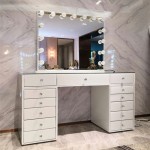Can You Put a Mirror in the Shower?
The idea of having a mirror in the shower might sound like a luxury, but it's actually a practical and convenient addition to any bathroom. A shower mirror allows you to shave, apply makeup, or simply check your appearance without leaving the steamy confines of your shower. However, placing a mirror in a shower presents a unique set of challenges due to the constant exposure to moisture and fluctuating temperatures. This article will discuss the feasibility of installing a mirror in your shower, the different options available, and the factors to consider for a successful and long-lasting installation.
The Challenges of Installing a Shower Mirror
The primary concern when installing a shower mirror is its susceptibility to damage from moisture. The constant exposure to steam and water can cause the mirror to fog up, become discolored, and even crack over time. Additionally, the fluctuating temperatures in the shower environment can put stress on the mirror's adhesive or mounting hardware, potentially causing it to loosen or fall off. These challenges make it essential to choose the right type of mirror and installation method to ensure its durability and longevity.
Types of Shower Mirrors
Two primary types of mirrors are designed specifically for use in showers: fog-resistant mirrors and waterproof mirrors. Fog-resistant mirrors have a special coating that prevents condensation from forming on their surface, allowing for a clear view even in a steamy shower. Waterproof mirrors, on the other hand, are designed for complete immersion in water and are often made of tempered glass to resist cracking or shattering. These mirrors are ideal for showers that have a tendency to splash water directly on the mirror surface.
The choice between fog-resistant and fully waterproof mirrors largely depends on the shower's design and the level of exposure to water. For showers with good ventilation and minimal water splashing, a fog-resistant mirror might suffice. However, for showers with large showerheads or a tendency to splash water on the mirror, a waterproof mirror is recommended for optimal performance and longevity.
Installation Considerations for a Shower Mirror
The installation of a shower mirror requires careful planning and consideration of several factors. The first step is to choose the appropriate mounting method. There are various options available, including adhesive mounting, suction cups, or traditional screw mounting. Adhesive mounting is a convenient and discreet option, while suction cups provide a temporary and removable solution. Screw mounting offers the strongest and most secure attachment, but it requires drilling into the wall and may not be feasible for all shower surfaces.
The location of the mirror is another crucial factor to consider. It should be positioned in a convenient location that allows for easy access and visibility while showering. Additionally, it's crucial to choose a spot that is not directly exposed to splashing water or harsh cleaning chemicals. The ideal position is often above the showerhead or on a side wall, depending on the layout of the shower.
After choosing the location and mounting method, it's important to properly prepare the surface for installation. This involves cleaning the wall thoroughly to remove any dirt, grime, or residue that could interfere with the adhesion of the mirror. For screw mounting, ensure that the chosen location can accommodate the screw size and type.
Finally, after installing the mirror, it's essential to allow the adhesive or mounting hardware to cure completely before using the mirror. This ensures a secure attachment and prevents the mirror from falling off prematurely. By following these tips, you can ensure a successful and long-lasting installation of your shower mirror.
Additional Tips for Shower Mirror Maintenance
To maintain the functionality and longevity of your shower mirror, follow these simple tips:
- Clean the mirror regularly with a mild soap or glass cleaner to prevent the buildup of soap scum, hard water deposits, and other residues that can cloud the mirror's surface.
- Avoid using abrasive cleaners or harsh chemicals as they can damage the mirror's coating or surface.
- If the mirror is fog-resistant, do not apply any additional coatings or sprays as these can interfere with the existing coating and reduce its effectiveness.
- Ensure proper ventilation in the shower to minimize condensation and promote the drying of the mirror.
By considering these factors and following the recommended installation and maintenance procedures, you can enjoy the convenience and aesthetic appeal of a shower mirror for many years to come.

How To Hang Install A Bathroom Mirror By Mira Showers

How To Install A Mirror Without Frame Merrypad
:strip_icc()/Design_CathieHongInteriorsPhoto_ChristyQPhotography-1f0a7254eb7a435aa80046b0bf60d33b.jpg?strip=all)
10 Feng Shui Rules For Mirrors According To Experts

How To Pick And Hang The Perfect Bathroom Mirror Roomhints

28 Bathroom Mirror Backsplash Elegant Ideas

How To Install A Bathroom Mirror The Home Depot
:max_bytes(150000):strip_icc()/midcentury-bathroom-5a1f3dfb4e46ba001aa8b230.jpg?strip=all)
13 Beautiful Mirrored Bathrooms

How To Pick And Hang The Perfect Bathroom Mirror Roomhints

How To Hang Mirrors On Tile 3 Ways A Bonus The Palette Muse

Diy Bathroom Mirror Frame Without Removing Clips Her Happy Home








